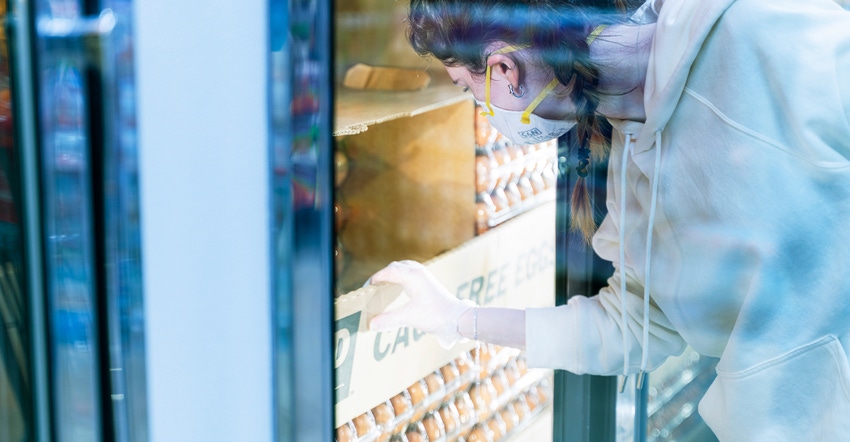
As communities and workplaces shut down last year due to COVID-19, the impact on food production was immediate. Processing and marketing chains were severely disrupted. Businesses and families found out just how choppy virtual connectivity was in rural areas. Add in political and trade challenges, and 2020 was a year for the record books.
During a virtual Commodity Classic session March 5, a panel of ag company executives looked back at lessons learned and how they are applicable in 2021. Participating on the panel were Polly Ruhland, CEO of the United Soybean Board; Brett Bruggeman, executive vice president, Land O’Lakes; Matt Plitt, executive vice president and COO of Valent U.S.A.; and Brett Davis, vice president of New Holland.
All panelists agreed that 2020 was a year that won’t be forgotten. Amid the challenges facing everyone, however, it was quite apparent that reliable food production and marketing were key.
“[COVID] highlighted the critical food security role that ag plays, and consumers hadn’t even thought about that, as farming and ag is impactful to them,” Ruhland said. “We have a unique opportunity to connect with the administration, our end users, customers and consumers in nourishing the world and the land.”
Topics discussed included:
Supply chain challenges will continue. Bruggeman said that the U.S. is sitting at the lowest amount of inventory ever. On top of that, the U.S. is looking at highest planted acreage this year and an early spring in parts of the country.
“We’ll really test the supply chain like we never have before,” he noted. Plitt said he believes they are here to stay, and that different factors will exacerbate that, such as West Coast port backups and weather challenges.
“Planning ahead with transparency and data plays a lot into how we generate our models for both production and the logistics of getting product from the farm to distribution and retail,” Plitt said.
Davis offered some optimism, but noted this year would be a challenge.
“Moving into 2022, we will move back to a point where we get somewhat normal,” Davis said.
One way to meet the challenge is to ensure that farmers know customer needs. Ruhland said full marketing chain partnerships are a must — from farmers to end users. Transparency and communication are required to make the system work.
“We’ve got to get better at partnering and be less afraid about talking to each other,” Ruhland said. She offered the example of the U.S. Army Corps of Engineers working with partners such as Minnesota Soybean to complete a Mississippi River dredging project.
When farmers know what customers want, they will provide it, she added. Case in point: high-oleic soybeans. Demand and expansion for that market have grown remarkably in last three years, she said — almost too fast. Now there are not enough acres getting planted to meet demand.
“We need to get that transparency going all the way to the farm level,” she said.
Interconnectivity is vital. With the transition to connecting online during the pandemic, it became obvious last year why everyone must have Wi-Fi access. Bruggeman noted that 14 million people in the U.S. still do not have broadband. Land O’Lakes is working with 135 companies to get a coalition established to work on connectivity. Next, they would work on developing blockchain technology — a way to share data from farm to table with multiple parties.
Ruhland said a Minnesota Soybean survey showed that 60% of farmers do not have connectivity to conduct basic office business. It also became apparent why connectivity is so important to rural America.
“It’s not just agriculture,” Ruhland said. “It’s first responders who can’t get to places because they can’t get connectivity. Schools are falling behind … Rural connectivity is a whole societal issue.”
Soil health and carbon credits are part of climate discussions. Bruggeman shared his company’s efforts to lay groundwork in developing the carbon credit industry. Land O’Lakes’ ag sustainability arm Truterra recently rolled out TruCarbon, a program that helps farmers generate and sell carbon credits to private-sector buyers.
“The real prize is looking forward … to double-cropping corn and double-cropping carbon,” Bruggeman said. “Since we launched TruCarbon with [partner] Microsoft, phones been ringing off the hook. It has endless market possibilities.”
Keep the workforce development pipeline full. Plitt emphasized the importance of diversity in demographics as well as skills. His company has a partnership program with three organizations —FFA; Ag Future of America; and Minorities in Agriculture, Natural Resources and Related Sciences.
Davis noted that colleges can play a role, too, in showing non-ag majors that there are career opportunities in ag. He cited an example of a college engineering school having students take hands-on ag equipment training.
Ruhland advocated for programs that introduce science to all students. “We can’t just pull ag kids to work in ag,” she said. “We need to interest kids in science and show them how ag impacts society.”
About the Author(s)
You May Also Like






